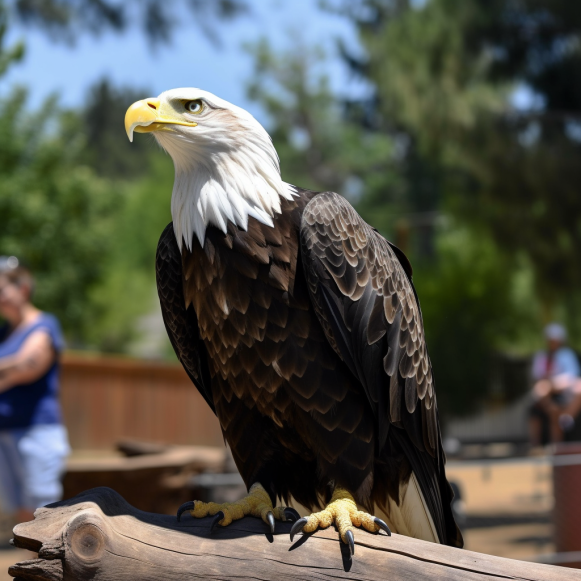Lindsay Wildlife Experience: Where animals teach humans about their life in the wild

The daily scene outside this specialty E.R. resembles that of other hospitals in some ways, with cars rushing into the parking lot to bring in sick and injured patients.
The arriving patients at Walnut Creek’s Lindsay Wildlife Experience, a nationally renowned museum and wildlife hospital, are native birds, small mammals, reptiles, and amphibians, tucked in cardboard boxes or wrapped in towels and blankets and carried by humans. A worker for a tree-trimming company recently delivered a young, severely injured red-tailed hawk.
The veterinary staff meets the patients outside, assesses their condition, and then transports them to the hospital, where they do everything possible to save them. If the animals survive the first 24 hours, they have an 80% chance of survival. Staff hope to rehabilitate and return these patients to their natural habitats, though some will be unable to do so due to injuries, such as damaged wings, that make hunting or escaping predators impossible.
Some of these rehabilitated patients who are unable to return to the wild work at Lindsay as “Animal Ambassadors.” Their survival stories provide insights into Bay Area native species and the challenges they face from people encroaching on their habitats.
Alexander “Sandy” Lindsay, a nature enthusiast who collected local specimens in his garage, founded the Lindsay Museum in 1955. The museum now occupies a gleaming 28,000-square-foot building on the outskirts of Walnut Creek’s Larkey Park, which houses the hospital, exhibit hall, educational program space, and a growing number of indoor and outdoor aviaries for its resident owls, hawks, a bald eagle, and other raptors.
The hospital was the first of its kind in the United States when it opened in 1970, and it is still the largest such rehabilitation center in the country. Every year, it treats over 5,000 injured, sick, or orphaned wild animals as part of the museum’s mission “to connect people with wildlife in order to inspire responsibility and respect for the world we share.”
Meeting the animal ambassadors is the highlight of the trip for the 100,000 children and adults who visit each year. Here are three must-see attractions.
White-tailed Kite, Dragon
Dragon, a graceful, snow-white hawk, gets its name from the way it hovers, kitelike, over open fields, scanning for prey.
Dragon arrived at Lindsay Hospital in 2017 as a young bird who had fallen from her nest. She performed admirably during her brief stay and appeared to be ready to return to the wild. However, the unusually calm kite returned two months later after sustaining a neurological injury in a collision with a building window. Dragon continues to receive treatment and rehabilitation at Lindsay, with her piercing call and eyes that will turn blood red when she reaches full maturity.
Tyro, an albino rattlesnake
Tyro had two strikes against him before arriving at the hospital in 2018. The first was that he is a Northern Pacific rattlesnake. A homeowner who discovered him in his backyard attacked him with a tree trimmer, apparently motivated by misguided fears of rattlesnakes’ danger to humans. In fact, rattlesnakes are shy and will do anything to avoid people.
Tyro was nearly killed in the attack. It injured his eye, broke his jaw, and cut him all over his pearly white body. His forked tongue had also fallen out, making it difficult for him to hunt for food. Tyro’s albinism is the other strike. Because the snakes are unable to blend in with their surroundings, they are vulnerable to the sun and predators.
Tyro is a calm and curious snake in his Lindsay enclosure, rarely rattles to indicate he is threatened, even when his keepers are cleaning nearby enclosures. Instead, he frequently raises his head to “periscope” – to observe and see what’s going on. “He’s a survivor,” says Lauren Amy, wildlife encounters manager.
Bald Eagle, Atsa
Given that bald eagles are the national bird and spiritual symbols for many Native American peoples, Atsa is one of Lindsay’s more glamorous ambassadors. Atsa, whose name means “eagle” in Navajo, came to Lindsay from a Missouri bird sanctuary when she was 13 years old. Two weeks after a windstorm destroyed her nest, she was rescued as a young eagle from a narrow ravine in northern Wisconsin. Her parents must have kept her alive by delivering food to her. Unfortunately, because of the delay in rescuing her, her broken wing never healed properly. Atsa navigates her aviary at Lindsay by leaping from branch to branch on powerful legs.
She is, among other things, one of the great success stories of the American environmental movement. Due to DDT, the bald eagle population in the United States plummeted in the 1960s and 1970s. Bald eagle populations rebounded after the pesticide was banned and the species was fully protected under the Endangered Species Act, and they were removed from the endangered species list in 2007.
The Lindsay Wildlife Experience museum is open to the public from 10 a.m. to 5 p.m. Wednesday through Sunday at 1931 First Ave. in Walnut Creek. Admission is $13-$15; visit https://lindsaywildlife.org/ for more information.




